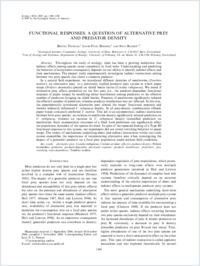Functional responses: a question of alternative prey and predator density
- Tschanz, Britta Zoological Institute, Community Ecology, University of Bern, Switzerland
- Bersier, Louis-Félix Unit of Ecology and Evolution, Department of Biology, University of Fribourg, Switzerland
- Bacher, Sven Zoological Institute, Community Ecology, University of Bern, Switzerland
-
2007
Published in:
- Ecology. - 2007, vol. 88, no. 5, p. 1300–1308
alternative prey
Cassida rubiginosa
Cirsium arvense
effective predator density
Polistes dominulus
predation
predator-dependent functional response
predator interference
preference
prey switching
ratio dependence, Tenebrio molitor
English
Throughout the study of ecology, there has been a growing realization that indirect effects among species cause complexity in food webs. Understanding and predicting the behavior of ecosystems consequently depends on our ability to identify indirect effects and their mechanisms. The present study experimentally investigates indirect interactions arising between two prey species that share a common predator.In a natural field experiment, we introduced different densities of mealworms (Tenebrio molitor), an alternative prey, to a previously studied predator–prey system in which paper wasps (Polistes dominulus) preyed on shield beetle larvae (Cassida rubiginosa). We tested if alternative prey affects predation on the first prey (i.e., the predator-dependent functional response of paper wasps) by modifying either interference among predators or the effective number of predators foraging on shield beetles. Presence of mealworms significantly reduced the effective number of predators, whereas predator interference was not affected. In this way, the experimentally introduced alternative prey altered the wasps' functional response and thereby indirectly influenced C. rubiginosa density. In all prey-density combinations offered, paper wasps constantly preferred T. molitor. This led to an asymmetrical, indirect interaction between both prey species: an increase in mealworm density significantly relaxed predation on C. rubiginosa, whereas an increase in C. rubiginosa density intensified predation on mealworms. Such asymmetrical outcomes of a fixed food preference can significantly affect the population dynamics of the species involved. In spite of the repeated finding of a Type III functional response in this system, our experiment did not reveal switching behavior in paper wasps. The variety of mechanisms underlying direct and indirect interactions within our study system exemplifies the importance of incorporating alternative prey when investigating the impact of a generalist predator on a focal prey population under realistic field conditions.
- Faculty
- Faculté des sciences et de médecine
- Department
- Département de Biologie
- Language
-
- English
- Classification
- Biological sciences
- License
- License undefined
- Identifiers
-
- RERO DOC 8085
- DOI 10.1890/06-1512
- Persistent URL
- https://folia.unifr.ch/unifr/documents/300296
Statistics
Document views: 140
File downloads:
- bersier_frq.pdf: 312
